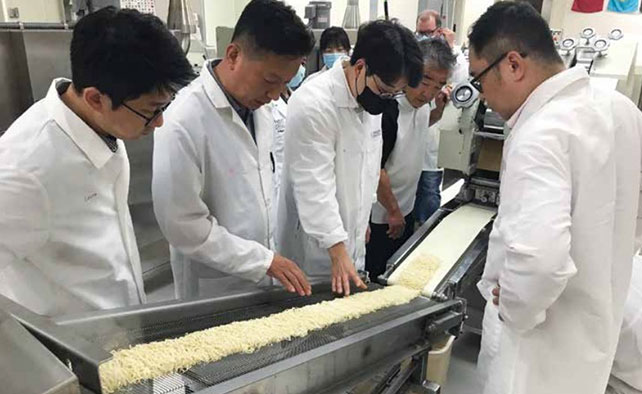U.S. Wheat climbs to meet needs of Korean industry
As they typically do, the South Korean wheat buyers who explored Washington, Oregon, and Montana in late July carried in the back of their minds a lengthy list — a long and growing lineup, actually — of food products back home that depend on high-quality wheat grown in the U.S.
Noodles remain a prime player in that lineup.
Important to U.S. wheat farmers is the fact that the noodle game in South Korea is increasingly reliant on U.S. wheat, specifically soft white (SW), hard red spring (HRS), and hard red winter (HRW) wheat, blended to stand more equally matched with competing wheat suppliers.
Before we get into the role U.S. wheat plays in the aforementioned “noodle game,” here are a handful of interesting facts about the noodle situation in South Korea:
- South Korea is second only to Vietnam in per capita consumption of instant noodles (ramen) in the world. Currently, the driving force behind the demand for wheat flour in Korea is the export of ramen.
- Among flour usage segments, the largest is the noodle market, which makes up 40% of the total. Bread flour (20%), all-purpose flour (16%), and cake flour (11%) follow behind.
- The noodle flour market in South Korea is broken down into three categories: instant noodles (55%), fresh noodles (30%), and dried noodles (15%).
- Instant noodles use a blend of U.S. wheat (60%) and Australian wheat (40%), while fresh and dried noodles mainly use Australian wheat due to its high viscosity and chewy texture.
In recent years, wheat farmers in Washington have heard U.S. Wheat Associates (USW) staff explain the importance of noodles in Korea, an extremely competitive and vital market for U.S. wheat exports. South Korea imports approximately 4.6 million tons of wheat annually. Since 2015, South Korea’s average annual imports of U.S. wheat have been 1.35 million tons. Last year, U.S. wheat imports surged to over 1.7 million tons, a 44% increase compared to 2023.

“In 2024, U.S. wheat held the largest share in the South Korean milling wheat market at 47.8%, followed by Australian wheat at 43.6%, and Canadian wheat at 8.6%,” said USW South Korea Country Director Dongchan “Channy” Bae. “Much of the credit for that goes to wheat farmers in the U.S. who continue to produce a crop that millers, bakers, and food manufacturers desire, because it helps increase the quality of end-products. We bring wheat buyers to areas like the Pacific Northwest to see the current crop in the field, to meet the farmers responsible for the crops, and to confirm the entire U.S. supply chain.”
Proving the ability of U.S. wheat classes to meet the standards of Korean noodle makers has been the job of USW. As mentioned above, for many years, Korean noodle makers preferred Australian wheat to produce noodle flour. But USW provided technical service that showed flour mills and instant noodle manufacturers that blends of flour from SW, HRS, and HRW wheat help improve texture in noodles and other end-products.
USW also positioned the reliability of U.S. wheat supplies to stand as an alternative to supply issues with Australian wheat. In recent years, USW has encouraged Korean flour mills to increase the blending ratio of SW and HRW wheat for noodle and multipurpose flour to reduce manufacturing costs.
USW’s work to grow demand includes USW’s Seoul office hosting an annual noodle flour blending seminar to demonstrate the advantages of blending with U.S. wheat. For the past decade, USW has also brought Korean teams to the U.S. for a Korean noodle flour development short course at the Wheat Market Center in Portland, Ore.
In 2024, USW’s noodle course for Korean manufacturers featured lessons on U.S. wheat classes and noodle flour quality analysis using the rapid visco analysis method. Participants also evaluated various blending tests that confirmed the advantages of U.S. wheat usage in instant noodle applications.
“The research and the information provided in the noodle courses prove that increased quantities of U.S. wheat classes in the blend maintain current product quality,” said Bae. “Our work also is designed to show participants that U.S. wheat farmers accept the responsibility to provide high quality U.S. wheat to overseas customers. We do that by taking teams to visit farmers and meet them on the farm.”
The article originally appeared in the August/September issue of Wheat Life Magazine.
Ralph Loos
Director of Commnications, U.S. Wheat Associates
